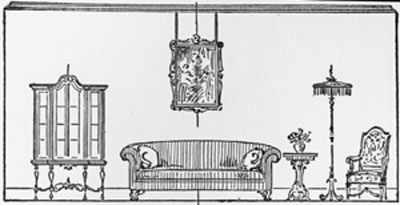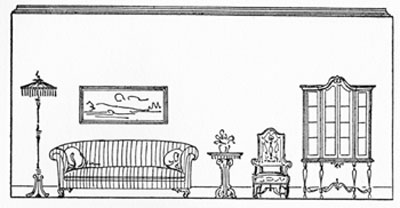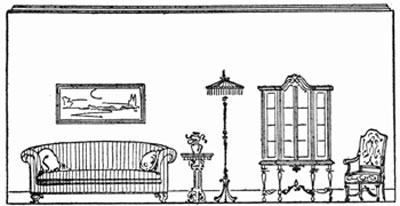Bisymmetric and Formal Balance
In the degree that the decorator finds it possible sufficiently to emphasize bisymmetric balance in the fixed decorations of the room, he will incline toward a more occult distribution of the movables. In the degree that he finds it impossible he must minimize the effect of deficiencies in structure through a greater emphasis upon formal balance in the distribution of movables. Thus in a room having symmetrically placed openings on three sides and the fourth wall blank, he will be likely to arrange the features on that wall in an occult balance. If, on the other hand, the openings of two or three walls are unsymmetrically placed, the blank wall will normally be arranged in formal balance, since such an arrangement will tend to restore the unity and repose of the whole treatment.

FIGURE 37.- The sofa and picture, constituting the most important element of the treatment, are in symmetrical balance. The cabinet on one side is balanced substitutionally by the composite group on the other side. Note however that a suggestion of symmetry is afforded by the fact that the cabinet and lamp are of the same height, and that their centers are equidistant from the center of the wall.
In formal balance the most important object will naturally be placed at the center of the wall. If there are two identical important elements they will be placed at either side of the center, at a distance determined by what use is to be made of the remaining wall space. In occult balance the most important object will be placed far enough from the center so that the mind will be in no doubt of the fact that it was not intended to be in the center, and at a distance determined by the decorative weight of the features on the other side, according to the formula that unequal attractions balance at distances inversely proportional to their weight.

FIGURE 38.- Occult balance, poorly arranged. Note that the cabinet appears to be a little too heavy; also that both cabinet and lamp affect the mind with a sense of constraint, due to their closeness to the end walls.
In the case of a large piece, like an upright piano, to be placed against a short wall, it will sometimes happen that the piece must be placed at the exact center, even though the decorator may desire to avoid by every means the appearance of formality or stiff ness in the room, since the wall space available is too short to permit the use of features sufficiently numerous and heavy to produce an occult balance. In this case he will fill the spaces at either side with features markedly dissimilar; for example, an English card table with some small accessories at one side and a floor lamp and chair at the other. Where the weight of one group is slightly greater than that of the other, he can restore the balance while adding to the diversity of the wall as a composition by placing a single small object, as a vase or plastic figure, on the piano toward the end near the lighter group.

FIGURE 39.- A better arrangement of the same elements in occult balance. The decorator would in practice be justified in placing the chair so near the end wall only in the case of a window in that wall which would make the chair usable. Every arrangement of furniture must be based first of all upon a study of all the considerations of fitness to function involved.
While it is the primary function of small decorative objects and of decoration volante generally to individualize the room and to give it animation, snap and decorative charm, it is clear that the decorator will need to resort to formal balance in distributing these objects in rooms where the openings and heavy pieces of furniture are markedly unsymmetrical. Thus a single small piece will, if placed above the center of a wall table or cabinet, emphasize the unity and repose, not only of the piece so embellished, but also of the room as a whole. The same effect, sharply intensified, will be produced by a pair of identical objects placed at equal distances from the center. On the other hand, two, three, four, or even five small, unimportant objects may be grouped in occult balance in such a way as to increase the animation and subtlety of the whole treatment.
 "Finally! Step-by-Step Guidebooks Show
"Finally! Step-by-Step Guidebooks Show